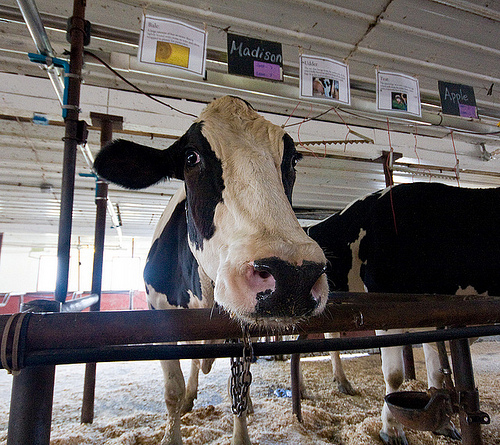
Jerri Marr, forest supervisor for the U.S. Forest Service, greets the crowd that gathered to thank the firefighters returning and leaving the fire camp Tuesday morning, July 3, 2012, at Holmes Middle School in Colorado Springs, Colo. The Waldo Canyon Fire is now 70 percent contained. (The Gazette, Christian Murdock)
Jerri Marr awoke on June 23, 2012, expecting a normal day as forest supervisor tending to issues on the Pike and San Isabel national forests west of Colorado Springs, Colo., and on the Comanche National Grassland, some 250 miles away. Not to mention the Cimarron National Grassland in southwest Kansas. That alone is enough to keep her days full. Read more »
At USDA, we’ve made record efforts in the past four years to support homegrown energy. This year, we’re looking ahead to a promising future for biofuels.
Biofuels have already contributed a great deal to our economy, to our energy security and to the bottom line on our farms and ranches. Today we’re taking steps to strengthen the biofuels industry and helping innovate the next generation of advanced biofuels.
For example, we’ve invested more than $320 million into biofuels research to help accelerate the development of technology needed to take the next big steps. Read more »

Dr. Muhammad Afzal of the UN Food and Agriculture Organization (FAO) holds a bottle of Foot and Mouth Disease (FMD) vaccine to show it becomes cloudy when it warms and is no longer usable. USDA helps keep FMD vaccinations cold and viable through its Program for the Progressive Control of Foot and Mouth Disease (FMD) in Pakistan.
Dr. Muhammad Afzal of the UN Food and Agriculture Organization (FAO) holds up a bottle of Foot and Mouth Disease (FMD) vaccine to show what happens when the cold chain is broken. The vaccine is spoiled, cloudy with precipitates and no longer effective. Fortunately, this was a test bottle and 500,000 additional doses of vaccine are safely stored in a modern cold room provided by USDA as part of its Program for the Progressive Control of FMD in Pakistan. Read more »

A dairy cow from Ronnybrook Dairy Farm. With the help of the Agricultural Marketing Service’s export certificates, dairy producers and manufacturers can send their products to 104 countries. Photo courtesy of Garrett Ziegler
Last year marked the first time in U.S. history that our dairy farmers produced more than 200 billion pounds of milk. This was the highest year over year increase since 2004-2005 and a 5.7 billion pound increase from the previous year. In recent years, more than two-thirds of the growing demand for U.S. farm milk has been for dairy exports. Read more »
USDA is committed to fostering a clean energy economy and to improving the environment by conducting operations in a sustainable and environmentally responsible manner, complying with environmental laws and regulations, and leading by example. In order to fulfill its mission of providing leadership on food, agriculture, natural resources, rural development, nutrition, and related issues, USDA focuses on the future. The Department recognizes the significance of global climate change and how potential impacts such as more frequent or severe weather events can affect our programs and operations.
To better coordinate USDA’s sustainability efforts and build on past success, USDA has prepared its 2012 Strategic Sustainability Performance Plan that underscores strategies and goals to save taxpayer dollars, reduce carbon emissions, cut waste and save energy. As part of this effort, this year we have also prepared a Climate Change Adaptation Plan that outlines how the Department will address the impacts of climate change on its key mission areas such as agricultural production, food security, rural development, and forestry and natural resources conservation. The plan is available and open for a 60-day public comment period.
The USDA Climate Change Adaptation Plan includes input from eleven USDA agencies and offices. It provides a detailed vulnerability assessment, reviews the elements of USDA’s mission that are at risk from climate change, and provides specific actions and steps being taken to build resilience to climate change. The plan advances President Obama’s efforts to prepare the federal government for climate change. We expect to revise and update the plan in 2013 in response to comments received from the public. Read more »
Almost three years ago, two biology professors at Delta State University in Mississippi brainstormed how to give science undergraduates research experience in microbiology and entomology.
They hit upon the idea of searching for “science gold” in the bellies of bugs.
Professors Tanya McKinney and Ellen Green received $40,000 through a grant for under-represented colleges from the U.S. Forest Service to help with the project. As part of their research experience, students in the program search the guts of beetle larvae to discover new cellulases, enzymes that break down cellulose, an organic compound that helps make plant cell walls rigid.
Read more »



